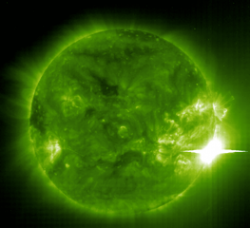The IceCube group of the Vrije Universiteit Brussel has just released a preprint which could be of a great interest for solar flare neutrino searches

Solar flares are the most energetic explosions in the solar system. They happen in the atmosphere of the Sun. The total energy released during a solar flare is bigger than a billion nuclear weapons. It could affect satellites and telecommunications for example.
Solar flares produce a lot of particles, including neutrinos, the ones we like to call “the ghost particles”. As pointed by Gwenhaël de Wasseige, PhD student at the VUB: “Detecting these neutrinos would be a breakthrough for solar physics.” Unfortunately, nobody succeed up to date.
IceCube, the largest and coolest detector in the World since it is located at the South Pole, could make it possible because of its km3 of Antarctic ice turned into a neutrino detector. Together with the universities from Wisconsin and Delaware and the Observatoire de Paris, Gwenhaël de Wasseige and the team of the Vrije Universiteit Brussel have developed a totally new way to search for these interesting neutrinos by using satellite data. She continues: “By defining a specific solar flare sample, we will be able to increase the probability to discover solar flare neutrinos and could open a new era in solar flare physics.”
Contact: Gwenhaël de Wasseige and Nick van Eijndhoven.
On the detection of neutrinos from solar flares using pion-decay photons to provide a time window template - http://arxiv.org/abs/1505.05837